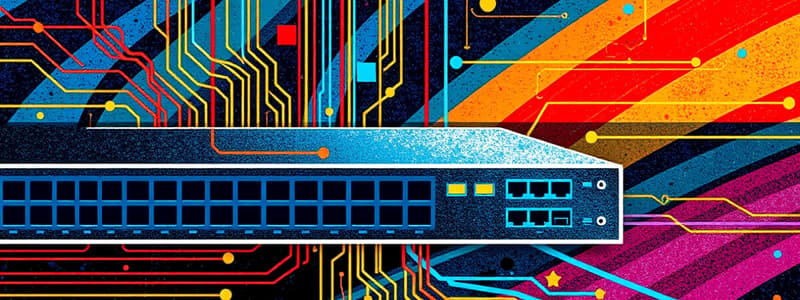Podcast
Questions and Answers
What does the data plane in networking primarily handle?
What does the data plane in networking primarily handle?
- Adjustments of packet scheduling policies
- Global routing decisions across networks
- Management of address translations
- Local forwarding of datagrams per router (correct)
Which of the following best describes the control plane's responsibility?
Which of the following best describes the control plane's responsibility?
- Performing link layer operations
- Routing datagrams from source to destination (correct)
- Processing incoming data headers
- Direct management of output ports
What is a key feature of the IPv6 protocol?
What is a key feature of the IPv6 protocol?
- A larger address space (correct)
- Support for Network Address Translation
- Enhanced security protocols
- Limited address space compared to IPv4
What best describes a middlebox in networking?
What best describes a middlebox in networking?
Which model allows for actions based on matching packet header fields?
Which model allows for actions based on matching packet header fields?
What is the primary function of buffering in networking?
What is the primary function of buffering in networking?
In networking, what is 'routing' primarily concerned with?
In networking, what is 'routing' primarily concerned with?
Which type of switching fabric is characterized by a shared communication path?
Which type of switching fabric is characterized by a shared communication path?
What is a characteristic of the OpenFlow protocol?
What is a characteristic of the OpenFlow protocol?
What happens to datagrams when buffers reach capacity and drop policies are applied?
What happens to datagrams when buffers reach capacity and drop policies are applied?
Flashcards are hidden until you start studying
Study Notes
Network Layer Overview
- The data plane operates locally on routers to forward incoming datagrams to the correct output ports.
- The control plane employs network-wide logic, determining the routing of datagrams from the source to the destination, using traditional algorithms and Software-Defined Networking (SDN) approaches.
What’s Inside a Router
- Input ports manage incoming data, perform link layer processing, and handle queuing of packets.
- Switching components transfer datagrams from input to output ports using forwarding tables.
- Output ports control outgoing data, queuing, and scheduling mechanisms for efficient packet transmission.
IP: The Internet Protocol
- Datagram format defines the structure of data packets for transmission.
- Addressing identifies devices on the network, essential for communication.
- Network Address Translation (NAT) alters IP addresses in packet headers to enable routing through private and public networks.
- IPv6 introduces a larger address space, accommodating an increasing number of devices on the internet.
Generalized Forwarding and SDN
- Match+Action is a forwarding model where packet processing actions are based on the match of packet header fields.
- OpenFlow is a key protocol in SDN, supporting the match+action forwarding principle.
Middleboxes
- Middleboxes are additional network devices that offer various services beyond routing, such as firewalls, load balancers, and proxies.
Network Layer Functions
- Forwarding refers to directing packets from an input link to the appropriate output link based on routing decisions.
- Routing involves determining the best pathway for packets to travel from source to destination.
Switching Fabrics
- Types of switching fabrics include Memory, Bus, and Interconnection Network, each affecting data transfer efficiency.
- The switching rate indicates how rapidly packets are forwarded from inputs to outputs within a router.
Buffer Management
- Buffering is necessary when datagrams arrive at a rate exceeding the link's transmission capacity to prevent data loss.
- Drop policies like tail drop dictate which datagrams are discarded when buffers reach capacity.
- Marking techniques signal congestion levels using methods like Explicit Congestion Notification (ECN) and Random Early Detection (RED).
Packet Scheduling
- First-Come, First-Served (FCFS) processes packets based on their order of arrival.
- Priority scheduling allows packets to be sent based on predefined priority levels.
- Round Robin (RR) cycling method sends packets equally across classes in a rotating manner.
- Weighted Fair Queueing (WFQ) delivers service based on different traffic class weights, ensuring fair distribution of bandwidth.
Network Service Models
- Best Effort service model provides no guarantees regarding packet delivery, timing, or bandwidth availability.
- Integrated Services (Intserv) model offers specific delivery guarantees for timing and bandwidth.
- Differentiated Services (Diffserv) establishes various levels of service quality to meet different network needs.
Studying That Suits You
Use AI to generate personalized quizzes and flashcards to suit your learning preferences.



